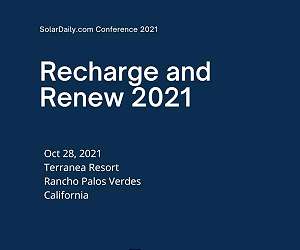Scientists at The University of Manchester have found a way to accelerate the uptake of solar technology, by increasing the environmental safety of perovskite solar cells.
Perovskite solar cells have attracted interest because, unlike silicon solar cells, they can be mass produced through roll-to-roll processing. Additionally, they are light and colourful, with the versatility to be used in non-traditional settings such as windows and contoured roofs.
However, up until now, application has been impacted by potential environmental risks. Perovskite solar cells contain lead, a cumulative toxin, and if the cells get damaged, lead ions may leak.
Taking lessons from nature, Professor Brian Saunders and Dr David Lewis have devised a way to eliminate the lead release from broken cells. Using a bioinspired mineral called hydroxyapatite, a major constituent of human bone, they have created a ‘failsafe’ which captures the lead ions in an inorganic matrix. As a result, if cells are damaged, toxins are stored in an inert mineral, rather than released in the environment.
In a dual success, The Engineering and Physical Sciences Research Council (EPSRC)-funded project found that through the addition of hydroxyapatite, the efficiency of perovskite solar cell increased to around 21%. This compares to around 18% efficiency for control cells with no added hydroxyapatite. An increased efficiency in panels means more energy can be generated and at a lower cost.
The research team hope that the cells will bring forward the large-scale application of perovskite solar cell technology. Professor Brian Saunders, Professor of Polymer and Colloid Chemistry at the School of Materials, The University of Manchester, said: “Up until now, the substantial lead component in perovskite solar cells has been a potential environmental concern. If the solar cells are damaged, for example by hail, the ions may leak.
“By creating an in-device fail-safe system, we have devised a way to contain toxic ions in damaged perovskite cells. Through increasing the inherent safety of perovskite solar cells, we hope our research will provide a helping hand to the wider deployment of solar technology as we strive to achieve net zero CO2 emissions.”
Dr David Lewis, Deputy Head of Department and Reader in Materials Chemistry, added, “We embarked on this research as we were committed to eliminating an environmental risk. That commitment has resulted in increasing both the sustainability and the efficiency of perovskite solar cells. We hope these dual outcomes will increase the viability for homes and businesses, worldwide, to host and use solar technology.”
The research was reported in: ‘Bioinspired scaffolds that sequester lead ions in physically damaged high efficiency perovskite solar cells’ in Chemical Communications.
Related Links
University of Manchester
All About Solar Energy at SolarDaily.com
|
We need your help. The SpaceDaily news network continues to grow but revenues have never been harder to maintain. With the rise of Ad Blockers, and Facebook – our traditional revenue sources via quality network advertising continues to decline. And unlike so many other news sites, we don’t have a paywall – with those annoying usernames and passwords. Our news coverage takes time and effort to publish 365 days a year. If you find our news sites informative and useful then please consider becoming a regular supporter or for now make a one off contribution. |
||
|
SpaceDaily Contributor $5 Billed Once credit card or paypal |
SpaceDaily Monthly Supporter $5 Billed Monthly paypal only |
|

![]()
Call for Speakers and White Paper for Recharge and Renew 2021 – Oct 28, 2021
Rancho Palos Verdes, CA (SPX) Feb 16, 2021
Paul Scott leads the pack with his speech prepared for Recharge and Renew 2021 with, “Why the internal combustion industry must die, and how we can kill it.”
Paul gives the audience another reason to hate ICE: Internal Combustion Engines.
His much younger self was a key player in the hit movie Who Killed the Electric Car. Over the years Paul pushed global manufacturers to release new electric vehicles. In fact, the Nissan Leaf Electric Vehicle owes many of its branches of customers to Paul. … read more
